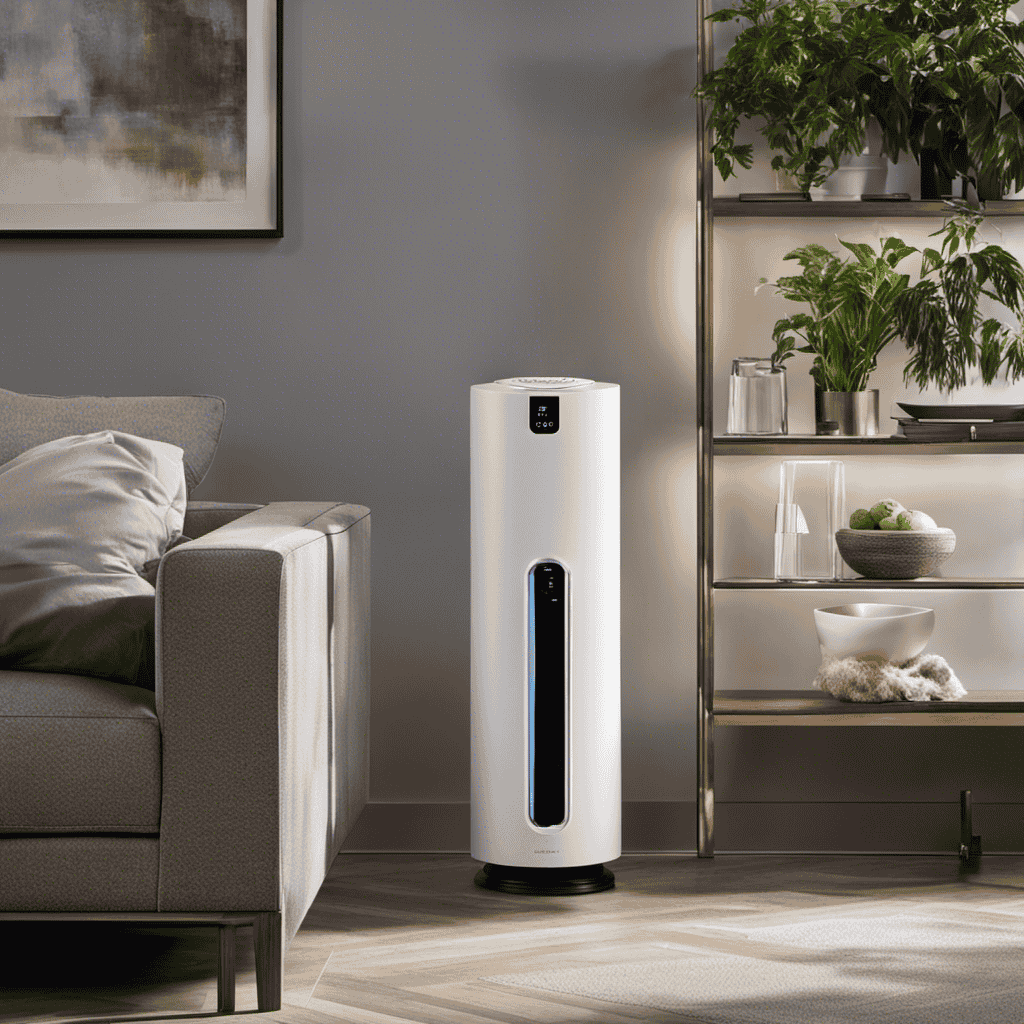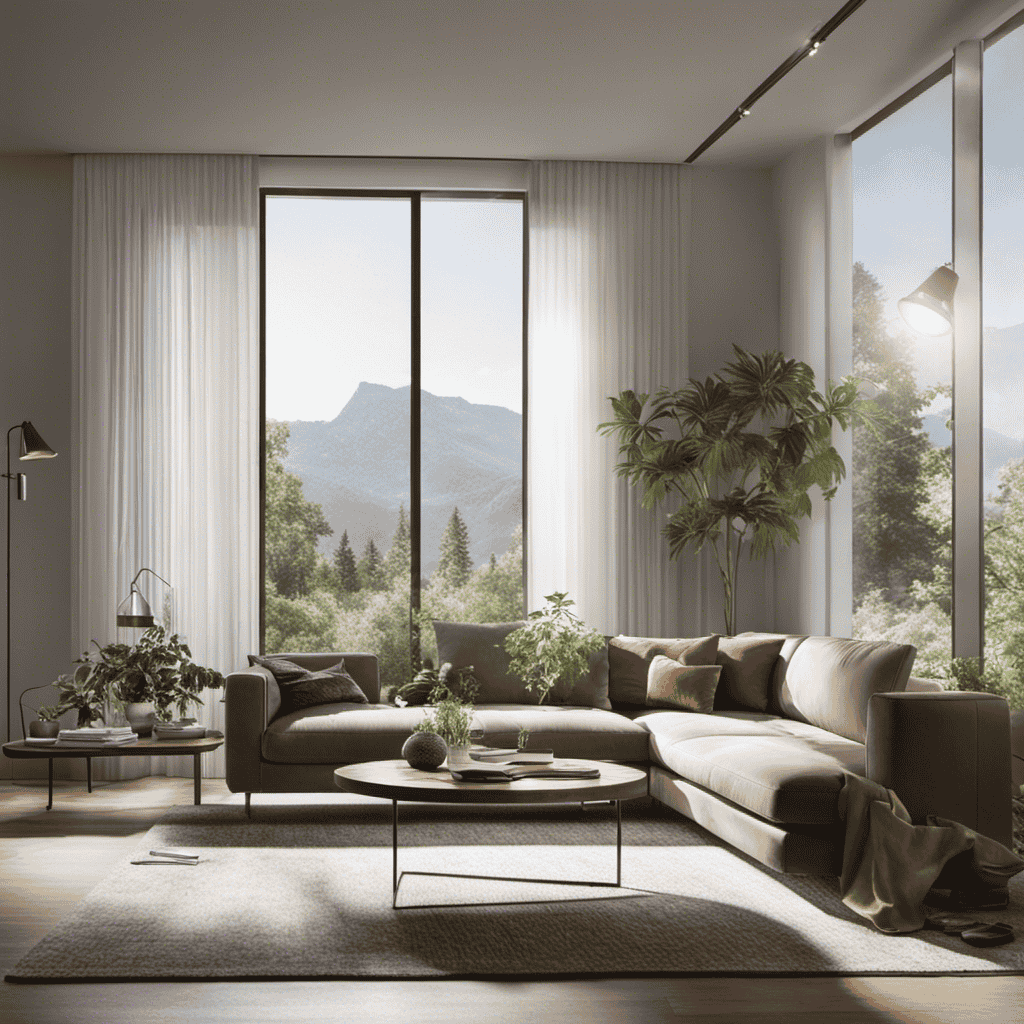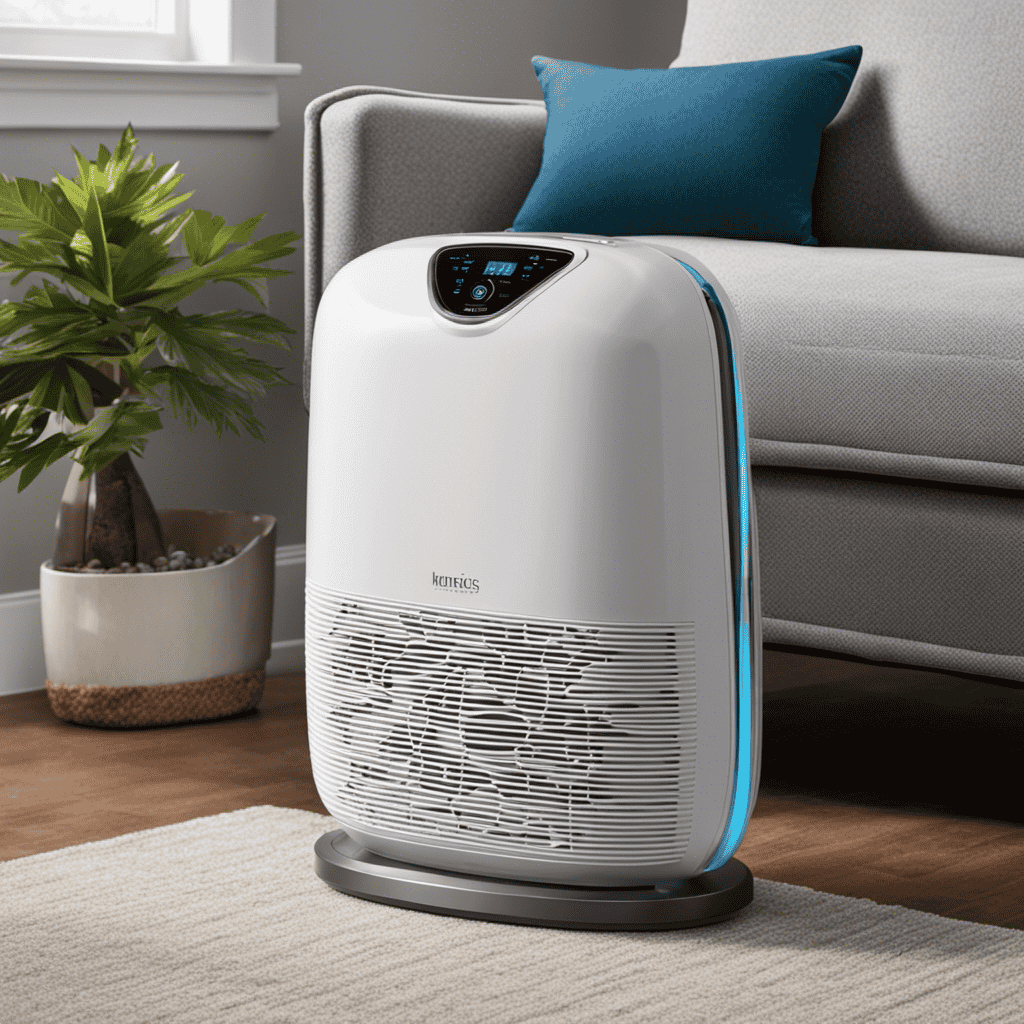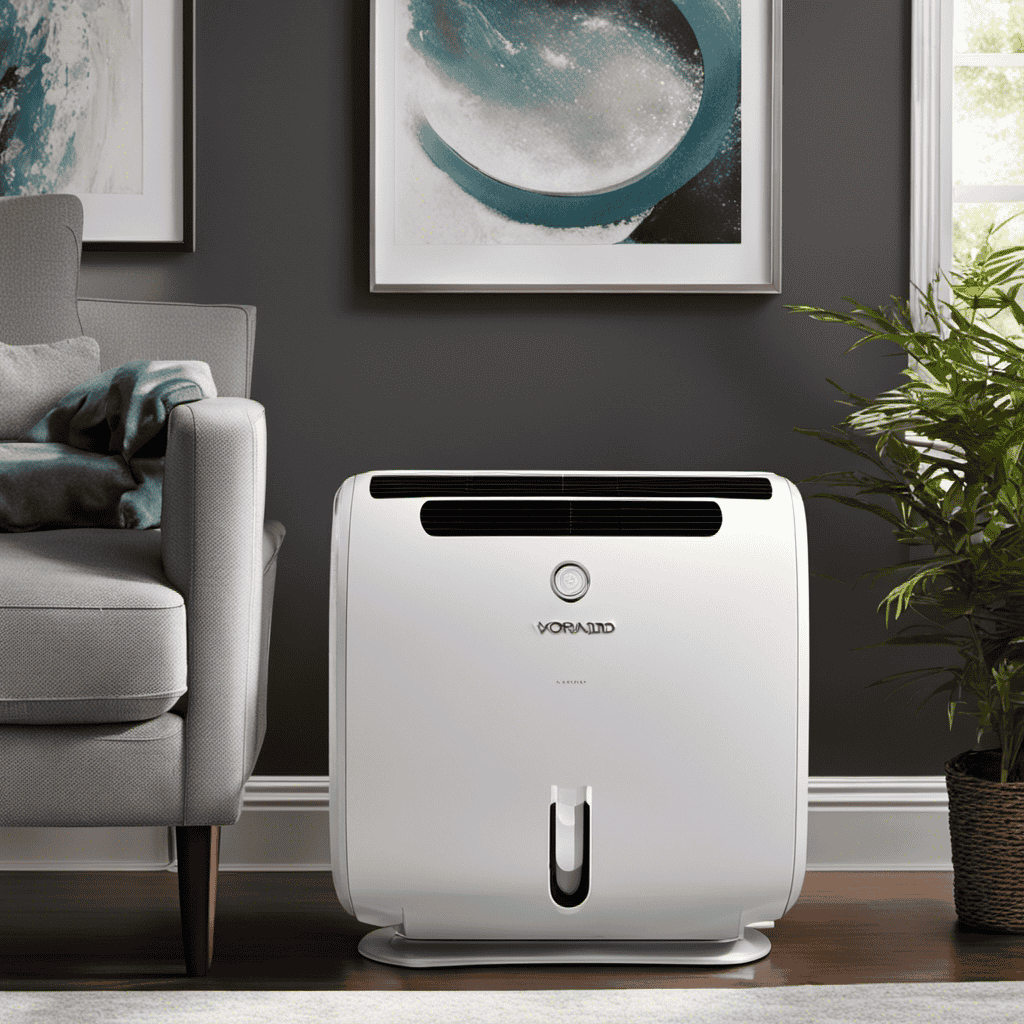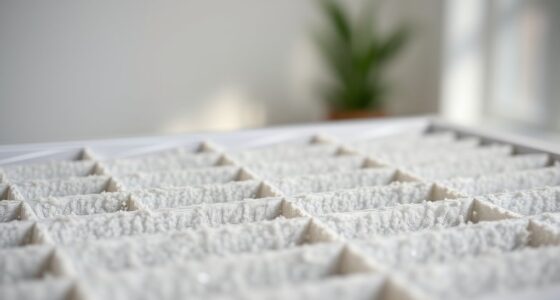As someone who frequently uses air purifiers, I have always been intrigued by the UV button and its function. What precisely is its purpose? How does it operate?
In this article, we’ll delve into the world of UV-C light and its role in air purifiers. By understanding the benefits and considerations of using the UV button, we can make informed decisions about improving air quality and removing airborne contaminants.
So, let’s shed some light on the UV button and its impact on our indoor environment.
Key Takeaways
- The UV button on an air purifier activates UV light to kill bacteria and viruses, making it beneficial for individuals with respiratory conditions and improving indoor air quality.
- UV technology in air purifiers kills germs, neutralizes odors, prevents the growth of mold and fungi, and prolongs the lifespan of air purifiers.
- UV-C light is effective in killing bacteria and viruses, destroying mold spores and fungi, breaking down volatile organic compounds (VOCs), and enhancing overall filtration when combined with other technologies.
- Safety precautions and maintenance of UV-C light include minimizing direct exposure, following manufacturer’s guidelines, keeping devices out of reach of children and pets, regularly cleaning and maintaining devices, and using protective gear.
The Purpose of the UV Button
If you’re wondering what the UV button on your air purifier does, it is designed to kill bacteria and viruses in the air. The UV button emits ultraviolet (UV) light, which has been proven to be effective in destroying microorganisms.
UV light has a wavelength that is capable of damaging the DNA and RNA of bacteria and viruses, preventing them from reproducing and causing harm. However, it is important to note that the effectiveness of the UV button in eliminating airborne pathogens depends on various factors such as the intensity of the UV light, exposure time, and the distance between the light source and the microorganisms.
Additionally, it is crucial to take safety precautions when using the UV button, such as avoiding direct exposure to the UV light and ensuring that the air purifier is properly maintained and cleaned to prevent the buildup of dust or contaminants.
How Does the UV Button Work
The UV button on an air purifier serves a crucial function in improving indoor air quality. By activating the UV light, it helps to kill bacteria, viruses, and other harmful microorganisms that may be present in the air.
This functionality is especially beneficial for individuals with respiratory conditions or those who are concerned about the spread of airborne diseases.
Additionally, the use of UV technology in air purifiers eliminates the need for chemical-based disinfectants, making it an environmentally friendly option.
UV Button Functionality
To activate the UV button on your air purifier, simply press it and enjoy the added germ-killing power. The UV button features advanced technology that effectively eliminates harmful bacteria, viruses, and other pathogens in the air.
Here are four reasons why the UV button is a valuable addition to your air purifier:
-
Enhanced air quality: The UV button destroys airborne microorganisms, ensuring cleaner and healthier air for you and your family.
-
Reduced allergies: By eliminating allergens such as mold spores and pet dander, the UV button helps alleviate allergy symptoms.
-
Odor elimination: The UV button breaks down organic compounds that cause unpleasant odors, leaving your home smelling fresh and clean.
-
Extended filter life: With the UV button actively killing germs, your air purifier’s filters will last longer, saving you money on replacements.
Benefits of UV Technology?
By harnessing the power of UV technology, you can effectively eliminate harmful bacteria, viruses, and other pathogens in your home, creating a safer and healthier environment for you and your family.
UV technology, specifically UV-C light, has been proven to be highly effective in killing microorganisms by disrupting their DNA and preventing them from reproducing. This technology is commonly used in air purifiers, water purifiers, and surface disinfection systems.
One of the key benefits of UV technology is its ability to provide continuous disinfection without the use of chemicals. Unlike traditional cleaning methods, UV-C light does not leave behind any residue or byproducts.
Additionally, UV technology is environmentally friendly and does not contribute to the development of antibiotic-resistant bacteria.
Overall, incorporating UV technology into your home can provide numerous advantages in terms of improved indoor air quality and a reduced risk of infection.
Understanding UV-C Light in Air Purifiers
UV-C light is a powerful tool used in air purifiers to effectively eliminate harmful microorganisms. Research has shown that UV-C light has the ability to destroy the DNA and RNA of bacteria, viruses, and other pathogens, rendering them unable to reproduce and cause harm.
In addition to its effectiveness in purifiers, UV-C light also offers several health benefits, including reducing the risk of respiratory infections and allergies.
However, it is important to take safety precautions when using UV-C light, such as wearing protective eyewear and ensuring the purifier is properly shielded to prevent direct exposure.
UV-C Effectiveness in Purifiers
Using UV-C light in air purifiers can effectively kill bacteria and viruses. This technology has several benefits that make it a popular choice for purifying indoor air:
-
Enhanced air quality: UV-C light has been proven to destroy microorganisms, including mold, bacteria, and viruses, improving the overall air quality in a room.
-
Reduced respiratory issues: By eliminating harmful pathogens, UV-C light can help reduce the risk of respiratory infections and allergies, providing a healthier environment for individuals with respiratory issues.
-
Odor elimination: UV-C light can also break down volatile organic compounds (VOCs), which are responsible for unpleasant odors. This helps to freshen the air and create a more pleasant living or working space.
-
Low maintenance: Unlike traditional air purifiers that require filter replacements, UV-C light purifiers have a longer lifespan and require minimal maintenance, making them a cost-effective and convenient option.
Health Benefits of UV-C
Incorporating UV-C light in purifiers can effectively improve indoor air quality and promote a healthier living or working environment.
UV-C light has been proven to have numerous health benefits, primarily due to its ability to kill or inactivate microorganisms such as bacteria, viruses, and mold spores.
By exposing the air to UV-C light, purifiers can effectively eliminate these harmful pathogens, reducing the risk of respiratory infections and allergies.
Furthermore, UV-C light can also help in reducing volatile organic compounds (VOCs) and odors, providing a fresher and cleaner indoor environment.
Studies have shown that the purification effectiveness of UV-C light can reach up to 99.9%, making it a valuable tool in maintaining a safe and healthy indoor air quality.
UV-C Safety Precautions
To ensure your safety, it’s important to follow proper precautions when using devices that emit UV-C light. UV-C light can be harmful if not handled correctly. Here are four key safety measures to keep in mind:
-
Limit exposure: Minimize direct exposure to UV-C light, as prolonged exposure can damage the skin and eyes. Use protective gear like gloves and goggles when necessary.
-
Follow instructions: Always read and follow the manufacturer’s guidelines for using UV-C devices. This includes operating the device at the recommended distance and time intervals.
-
Keep out of reach: Keep UV-C devices out of the reach of children and pets, as they may inadvertently expose themselves to the harmful light.
-
Regular maintenance: Ensure that UV-C devices are regularly cleaned and maintained to maximize their effectiveness and minimize the risk of accidental exposure.
Benefits of Using the UV Button
You’ll love the benefits of having the UV button on your air purifier. The UV technology used in air purifiers has several advantages that can greatly improve indoor air quality.
One of the main benefits is its ability to kill germs and bacteria. The UV light emitted by the button can destroy the DNA and RNA of these microorganisms, rendering them unable to reproduce or cause harm. This is especially beneficial for those with respiratory conditions or weakened immune systems.
Another advantage is its ability to neutralize odors. The UV light breaks down volatile organic compounds (VOCs) that are responsible for unpleasant smells, leaving your home smelling fresh and clean.
Lastly, the UV button can help prolong the lifespan of your air purifier by preventing the growth of mold and other fungi on the filters.
Overall, the UV button is a valuable addition to any air purifier, providing numerous benefits for your health and well-being.
UV-C Light and Airborne Contaminants
When it comes to air purifiers, understanding their effectiveness is crucial in making an informed decision.
One key aspect to consider is the use of UV-C light, which has been shown to have several benefits in improving air quality.
Additionally, the removal of airborne contaminants is a primary goal of air purifiers, and understanding how they achieve this can help determine their overall effectiveness.
Air Purifier Effectiveness
The uv button on air purifiers can help improve their effectiveness. Here are four reasons why this feature is important for air purifier technology and indoor air quality:
-
Eliminates bacteria and viruses: The UV-C light emitted by the air purifier’s UV button can effectively kill bacteria and viruses in the air, reducing the risk of respiratory infections.
-
Destroys mold and fungi: UV-C light has the ability to destroy mold spores and fungi, preventing their growth and spread in your indoor environment.
-
Neutralizes odors: The UV-C light can break down volatile organic compounds (VOCs) that contribute to unpleasant odors, leaving your indoor air smelling fresh and clean.
-
Enhances overall filtration: When combined with other filtration technologies, such as HEPA filters, the UV button can provide an extra layer of protection by targeting and neutralizing harmful microorganisms.
UV-C Light Benefits
In my research on air purifier effectiveness, I’ve come across the UV-C light feature and its uses.
The UV button on an air purifier activates a UV-C light, which is a specific type of ultraviolet light.
UV-C light has been shown to effectively kill or inactivate certain microorganisms, such as bacteria, viruses, and mold spores.
When the UV-C light is turned on, it shines onto the air passing through the purifier, neutralizing these harmful particles.
This feature can be particularly beneficial for individuals with allergies or respiratory conditions, as it helps to improve indoor air quality by reducing the presence of these harmful microorganisms.
However, it’s important to note that the effectiveness of the UV button may vary depending on factors such as the duration and intensity of the UV-C light exposure.
Therefore, it’s recommended to follow the manufacturer’s guidelines for optimal usage.
Airborne Contaminants Removal?
Activated UV-C light effectively neutralizes and removes harmful microorganisms like bacteria, viruses, and mold spores from indoor air. This technology plays a crucial role in improving air quality and creating a healthier living environment. Here are four reasons why activated UV-C light is an essential feature in air purifiers:
-
Powerful disinfection: UV-C light has the ability to destroy the DNA and RNA of microorganisms, rendering them unable to reproduce or cause harm.
-
Comprehensive coverage: UV-C light can reach every corner of a room, disinfecting the air as well as surfaces, such as furniture, carpets, and walls.
-
No harmful byproducts: Unlike chemical disinfectants, UV-C light does not produce any harmful residues or byproducts, making it safe for use in homes and offices.
-
Continuous purification: Air purifiers equipped with UV-C light provide continuous air purification, ensuring that harmful microorganisms are constantly neutralized, allowing you to breathe cleaner, healthier air.
With the advancements in air purifier technology, incorporating UV-C light is a game-changer in air quality improvement.
Is the UV Button Necessary for Air Purification
Is the UV button really necessary for air purification? When it comes to air purifiers, the UV button is often touted as a key feature for enhanced effectiveness. But is it truly necessary? Let’s delve into the research to find out.
| UV Button Effectiveness | UV Button Safety | Other Factors |
|---|---|---|
| UV light can eliminate certain microorganisms and allergens | UV light can be harmful to humans and pets if not used properly | Proper maintenance and filter replacement play a crucial role in air purification |
| Effectiveness varies depending on the specific model and UV light intensity | Exposure to UV light can cause skin and eye irritation | Consider the size of the room and the level of air pollution when determining the need for a UV button |
While the UV button can enhance air purification by eliminating certain microorganisms and allergens, safety precautions must be taken to avoid potential harm. It is important to follow the manufacturer’s instructions and use the UV button responsibly. Additionally, factors such as proper maintenance and regular filter replacement should not be overlooked, as they contribute significantly to the overall effectiveness of an air purifier. Ultimately, the necessity of the UV button depends on individual circumstances and preferences.
UV Light and Bacteria in the Air
Using UV light in air purification can effectively eliminate bacteria present in the air. UV technology has a significant impact on indoor air quality, specifically in reducing air pollution caused by bacteria. Here are four reasons why UV light is beneficial for air purification:
-
Kills bacteria: UV light damages the DNA structure of bacteria, preventing their reproduction and effectively eliminating them from the air.
-
Reduces health risks: By eliminating bacteria, UV light helps reduce the risk of respiratory infections and other health issues caused by airborne bacteria.
-
Safe and chemical-free: UV light is a natural and chemical-free method of air purification, making it environmentally friendly and safe for human exposure.
-
Continuous protection: Unlike other air purification methods, UV light provides continuous protection against bacteria, ensuring a clean and healthy indoor environment.
UV-C Light Vs. HEPA Filtration
In my research, I’ve found that UV-C light is highly effective in killing airborne bacteria and viruses by damaging their DNA.
However, HEPA filtration is also beneficial as it can capture and remove particles as small as 0.3 microns, including allergens and pollutants.
Combining UV-C light with HEPA filtration can provide optimal air purification by both killing and removing harmful particles, ensuring a cleaner and healthier indoor environment.
Effectiveness of UV-C
You’ll be pleased to know that the UV-C feature on air purifiers is highly effective at killing bacteria and viruses. Here’s why UV-C light technology is so effective in air purification:
-
Destruction of DNA and RNA: UV-C light damages the genetic material of bacteria and viruses, disrupting their ability to replicate and survive.
-
Elimination of Microorganisms: UV-C light can effectively eliminate a wide range of harmful microorganisms, including mold spores, fungi, and airborne pathogens.
-
Non-Toxic and Chemical-Free: Unlike some other disinfection methods, UV-C light does not require the use of harmful chemicals, making it a safe and eco-friendly option.
-
Continuous Protection: Once installed, the UV-C feature can provide continuous air disinfection, ensuring that your indoor environment remains clean and healthy.
With UV-C technology, you can have peace of mind knowing that your air purifier is actively working to eliminate bacteria and viruses from the air.
Now, let’s explore the benefits of HEPA filtration.
Benefits of HEPA
To maximize the effectiveness of your filtration system, consider the benefits of HEPA technology.
HEPA filtration, which stands for High Efficiency Particulate Air, is a type of air purification method that is highly effective in removing airborne particles. It works by using a dense filter that captures particles as small as 0.3 microns, including dust, pollen, pet dander, and even some bacteria and viruses.
HEPA filters are commonly used in air purifiers, vacuum cleaners, and HVAC systems to improve indoor air quality. By incorporating HEPA filtration into your filtration system, you can significantly reduce the presence of allergens and other harmful particles in the air you breathe. This technology is especially beneficial for individuals with allergies, asthma, or respiratory conditions.
Additionally, HEPA filters can be combined with other technologies like UV-C to provide even greater air purification capabilities.
Combination for Optimal Purification
For optimal purification, consider combining HEPA filtration with other technologies like UV-C for even greater effectiveness. When it comes to purifying the air in your home, using multiple techniques can provide enhanced results. Here are four reasons why combining HEPA filtration with UV-C technology is a winning combination:
-
Enhanced Germ Elimination: HEPA filters are excellent at capturing airborne particles, but they may not be as effective against germs. UV-C technology, on the other hand, uses ultraviolet light to kill bacteria and viruses, providing an extra layer of protection.
-
Odor Reduction: HEPA filters can help remove odors, but the addition of UV-C technology can further neutralize unpleasant smells by breaking down volatile organic compounds (VOCs).
-
Allergy Relief: HEPA filters are known for their ability to trap allergens like pollen, pet dander, and dust mites. By adding UV-C technology, the air purifier can also target mold spores and other allergens.
-
Comprehensive Air Purification: Combining HEPA filtration with UV-C technology ensures a thorough and comprehensive purification process, addressing a wide range of airborne contaminants.
Safety Precautions for Using the UV Button
Make sure you’re aware of the safety precautions when using the UV button on your air purifier. Safety measures are essential to ensure proper usage and to avoid any potential harm.
When using the UV button, it is important to remember that UV-C light can be harmful to humans and should not be directly exposed to the skin or eyes. Always make sure to keep the UV button out of reach of children and pets. Additionally, it is crucial to follow the manufacturer’s instructions for the recommended duration of UV exposure.
Remember, the UV button is designed to kill germs and bacteria in the air, but it should not be relied upon solely for the removal of allergens.
In the next section, we will discuss how UV-C light can help in reducing allergens in the air.
UV-C Light and Allergens in the Air
Did you know that UV-C light has the potential to reduce allergens in your indoor environment? It’s true! UV-C light has been shown to effectively eliminate bacteria and mold spores, which are common triggers for allergies. Here are four ways that UV-C light can help improve your indoor air quality:
-
Killing Bacteria: UV-C light has been proven to destroy bacteria by disrupting their DNA, preventing them from reproducing and causing harm.
-
Eliminating Mold Spores: Mold spores can be a major problem for allergy sufferers. UV-C light can kill and prevent the growth of mold spores, reducing the risk of allergic reactions.
-
Reducing Allergen Levels: By targeting and eliminating allergens like bacteria and mold spores, UV-C light can significantly reduce the overall allergen levels in your indoor environment.
-
Improving Air Quality: With fewer allergens in the air, you can breathe easier and enjoy better indoor air quality.
Now that we understand how UV-C light can reduce allergens, let’s explore the question: can the UV button kill viruses?
Can the UV Button Kill Viruses
Now you may be wondering, can the UV-C light in your air purifier effectively kill viruses? The answer is yes, it can.
UV-C light has been proven to be an effective method for disinfecting air and surfaces. When the UV button is activated on your air purifier, the UV-C light is emitted, which can kill bacteria and viruses that are present in the air. This is because UV-C light damages the DNA and RNA of these microorganisms, preventing them from reproducing and causing infections.
However, it is important to note that the effectiveness of the UV button in killing viruses may depend on factors such as the intensity and duration of exposure.
In the next section, we will explore the impact of UV-C light on mold spores.
UV-C Light and Mold Spores
If you activate the UV-C light, it can also help in killing mold spores present in your environment. Mold spores are tiny particles that float in the air and can cause respiratory issues when inhaled. The UV-C light works by emitting short-wavelength ultraviolet light that damages the DNA and RNA of mold spores, preventing them from reproducing and spreading. This can have a positive impact on indoor air quality and respiratory health.
Here are four reasons why UV-C light is beneficial in addressing mold spores:
-
Reduces mold growth: UV-C light can inhibit the growth of mold on surfaces, reducing the chances of mold spores being released into the air.
-
Improves air purification: By killing mold spores, UV-C light enhances the effectiveness of air purifiers in removing these particles from the air.
-
Prevents allergic reactions: Eliminating mold spores can alleviate symptoms such as sneezing, coughing, and itching, benefiting individuals with allergies or asthma.
-
Combats musty odors: Mold spores are often responsible for unpleasant odors, and UV-C light can help eliminate these smells, improving the overall indoor environment.
Considering these benefits, it’s important to understand what factors to consider before using the UV button on your air purifier.
What to Consider Before Using the UV Button
Before activating the UV-C light, make sure to consider the potential impact on your indoor environment and the specific needs of individuals with allergies or asthma. While the UV button on an air purifier can offer benefits in terms of reducing microorganisms like bacteria and viruses, it is important to use it correctly and responsibly. Here are some usage tips to keep in mind:
| UV Button Benefits | UV Button Usage Tips |
|---|---|
| Kills bacteria and viruses | Use the UV-C light in conjunction with other air purification methods for maximum effectiveness. |
| Reduces the spread of germs | Follow manufacturer’s instructions on how long to run the UV-C light to achieve desired results. |
| Helps maintain a clean and healthy indoor environment | Keep in mind that UV-C light can be harmful to humans and pets, so make sure the area is unoccupied when the light is in use. |
| Provides an additional layer of protection against airborne pathogens | Regularly clean and maintain the air purifier to ensure optimal performance. |
UV-C Light and Odor Removal
The UV-C light can also help eliminate unpleasant odors in your indoor space. This powerful light is effective in breaking down odor-causing molecules, leaving your space smelling fresh and clean. Here are four ways UV-C light can help remove odors:
-
Neutralizes bacteria and mold: UV-C light has the ability to kill bacteria and mold spores that can cause unpleasant odors.
-
Removes pet odors: UV-C light can effectively neutralize the odors caused by pets, including urine and dander.
-
Eliminates cigarette smoke odor: The powerful UV-C light can break down the volatile organic compounds (VOCs) found in cigarette smoke, reducing the lingering smell.
-
Eradicates cooking odors: UV-C light can help eliminate strong cooking smells by breaking down the compounds responsible for those odors.
When using UV-C light for odor removal, it is important to take safety precautions. Avoid direct exposure to UV-C light and ensure that the device is used in accordance with the manufacturer’s instructions.
Maintenance and Care of the UV Button
To properly maintain and care for your UV button, make sure to follow the manufacturer’s instructions and avoid direct exposure to UV-C light.
UV buttons are an important component of air purifiers that help to eliminate harmful bacteria, viruses, and other microorganisms from the air.
To ensure the effectiveness of the UV button, it is recommended to clean it regularly. This can be done by gently wiping the surface with a soft cloth or using a mild cleanser.
Additionally, it is important to check the UV button periodically for any signs of damage or wear. If any issues are detected, it is best to contact the manufacturer for further assistance.
Is the UV Button on an Air Purifier Necessary for Effective Air Purification?
While UV light in air purifiers may enhance purification, it is not necessary for effective air cleaning. High-quality filters and proper air circulation are more important factors for removing allergens and pollutants. The UV button on an air purifier may offer an added layer of protection, but it is not essential for quality air purification.
Frequently Asked Questions
Can the UV Button on an Air Purifier Remove Pet Dander and Hair?
Yes, the UV button on an air purifier can help remove pet dander and hair. UV light has been shown to kill bacteria, viruses, and allergens, making it effective for reducing allergies and asthma symptoms.
Does the UV Button Eliminate Cooking Odors in the Air?
The UV button on an air purifier eliminates cooking odors in the air. It is effective in eliminating tobacco smoke and mold spores. Studies show that UV technology can reduce up to 99% of airborne contaminants.
Can the UV Button on an Air Purifier Prevent the Spread of Airborne Viruses?
The UV button on an air purifier can effectively disinfect the air by killing airborne pathogens, including viruses. However, prolonged exposure to UV light may pose potential health risks and should be used with caution.
Is It Safe to Use the UV Button Continuously Throughout the Day?
Continuous use of the UV button on an air purifier may pose health risks. According to a study, extended exposure to UV radiation can damage skin and eyes. It is important to use UV functions cautiously and follow manufacturer guidelines.
How Often Should the UV Button Be Replaced or Serviced for Optimal Performance?
I recommend cleaning the UV button on your air purifier every 6 months for optimal performance. The UV button helps eliminate harmful bacteria and germs in the air, making your indoor environment safer and healthier.
Conclusion
In conclusion, the UV button on air purifiers is like a secret weapon against airborne contaminants. It harnesses the power of UV-C light to zap away mold spores and other harmful particles, leaving your air fresh and clean.
By using the UV button, you can enjoy the benefits of improved indoor air quality and reduced odors. Just remember to take proper care of the UV button and perform regular maintenance to ensure its effectiveness.
So go ahead, press that button and let the magic happen!
